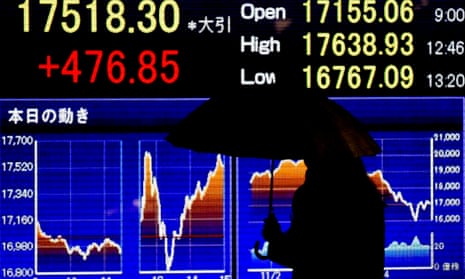The Bank of Japan (BoJ) has imposed negative interest rates on banks to encourage them to lend to businesses, instead of hoarding cash, to support the flagging economy and the country’s battle to break free of deflation.
The Japanese central bank’s board shocked markets on Friday by imposing a 0.1% fee on deposits left with it to encourage lending amid increasing uncertainty over the state of the global economy.
How do negative interest rates work?
Instead of earning interest on money left with the BoJ, banks are charged to park their cash. The idea is that instead of depositing money with the central bank or each other, they lend it to businesses and consumers. Banks may also cut deposit rates paid to customers, encouraging them to spend or invest instead of earning low or negative returns. Japan has been plagued by deflation – falling prices – for two decades, deterring consumer spending and business investment in the expectation that goods will become cheaper.
Negative interest rates are an example of “unconventional” monetary policy, which also includes quantitative easing – the buying of bonds from commercial banks by central banks, leaving them with excess cash. The BoJ said the move to negative interest rates was intended to support Japanese business confidence and to signal its determination to get inflation moving towards the target of 2%.
The negative rate will only apply to reserves in addition to existing deposits and those the central bank requires banks to have with it. This is designed to cushion banks’ earnings so that they do not become less willing to lend. The BoJ said, in a question and answer document, that interest rates and asset prices in financial markets would nevertheless be set on the basis of the negative rate.
Will it work?
It’s far from clear. Mario Draghi, president of the European Central Bank, has argued his unconventional policies – including negative rates – have helped the eurozone economy to ward off deflation. In theory the policy sounds attractive, but it could have unintended consequences. For example, banks could choose to pass on to customers the costs they incur for depositing money with the central bank through fees, or depositors could decide to keep their money under the mattress instead of in a bank.
A negative return on parking funds with the central bank might also encourage banks to invest in riskier assets to secure a return, potentially driving new asset bubbles and more pain further down the line.
In search of alternative investments, banks are likely to increase their purchases of government bonds. However, this has potentially serious consequences if banks are holding bonds to such an extent that government borrowing costs are artificially low. If a financial shock occurs, the banks and governments could find themselves so intertwined that they drag each other – and the economy – down.
Has it happened before?
In announcing its move, the BoJ cited examples of European central banks adopting negative interest rates. The main example is the ECB’s decision to pay negative interest rates from June 2014 in an attempt to stop the eurozone falling into a deflationary spiral.
Switzerland also adopted the measure last year to deter investors from buying francs, making Swiss imports uncompetitive.
Sweden and Denmark have also introduced negative deposit rates on a temporary basis in recent years. In Denmark, the aim was to cap an unwanted rise in its currency, which was pushed higher when foreign money flooded into the country as investors looked for safety outside the crisis-ridden eurozone. The move to negative deposit rates did not cause financial meltdown, with the Danish central bank issuing plenty of advance warning. Nor did it lead to a noticeable change in the interest rates charged by banks for bank loans.

Comments (…)
Sign in or create your Guardian account to join the discussion